tibetan thangka art
The Himalayan Times: Sacred Nepali art losing colors
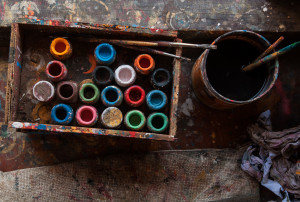 Extract from thehimalayantimes.com
Extract from thehimalayantimes.com
One of the traditions Nepal can really pride itself upon is the art of thangka paintings — which are so exquisite that foreigners have been known to extend their stay to learn the techniques. However, the rise of unhealthy competition, lack of regular-isation and emigration of artists is posing a threat to the inventive profession. Thangka is a Tibetan silk painting with embroidery, usually depicting a Buddhist deity, famous scene, or mandala. It is done on cotton canvas — found in Asian countries such as Tibet, Nepal, Bhutan, India and Mongolia — used exclusively for this purpose. Native Buddhists of Kathmandu valley call it ‘pauva chitra’ whereas it is also known as ‘tangka’, ‘thanka’, or ‘tanka’.
These paintings lucidly represent Buddhist deities and divinities that appear in sacred Buddhist practices called ‘sadhana’. This means artists are not allowed to use their imagination. There is also a belief that thangka emanates positive vibrations and good luck. “Thangkas may merely seem like beautiful and luxurious showpieces for those who are unaware about Buddhist beliefs. But for Buddhists, it is a sacred tool for meditation and purification of the soul,” says Anil Ghising, general secretary of Thangka Traders Association (TTA).
The most popular thangka designs include mandala, wheels of life and life of Buddha. They can be divided into three categories according to the quality — student piece, medium piece, and master-piece. Student piece is the work of a practitioner with a year’s experience, medium piece is the work of an artist who has over five years of experience, whereas master-pieces are created by artists with over 15 years of experience in thangka painting.
This is the major reason for the difference in the prices of similar-sized thangkas. The lack of uniformity in prices also depends upon size, art, toil and materials used. The price of thangkas begins at around Rs 500 and goes up to millions of rupees.
Meanwhile, Hajar Singh Lama, president of TTA, laments about the unhealthy competition in the market. He says, “The trend of pre-set contract with tourist guides is the major reason for such competition. Tourists are compelled to buy thangkas at the store specified by the guide, which is akin to deception.” According to him, the best way to stabilise the business is to draft and implement regulations for establishing thangka shops. Thamel, Bhaktapur and Boudha are the core areas for buying thangkas, whereas one can get them at Patan, Swoyambhu and Changu Narayan as well. According to TTA data, 222 thangka galleries function from Kathmandu valley, of which 72 are in Thamel.
Anil informs that the process of making thangka is very tedious. “An artist needs to meditate before starting his piece. Patience and dedication are essential to complete the assignment, which I feel is lacking in the new generation,” he says. Worried about the future of the industry, he suggests the government to include thangka and Buddhist scroll paintings in academia. He adds, “Thangka artists are gradually migrating to foreign lands, which threatens survival of the entire business. The government should carry out concrete work if it wants traditional art to be preserved for future generations.”
Another complaint of thangka artists is the lack of increment in business during ongoing Nepal Tourism Year. “The number of tourists has increased, but since majority of tourists come on special packages, our business has not fostered as we’d hoped,” laments Akka Lama, owner of Tibetan Thanka and School of Thanka Painting at Thamel. According to him, global economic crisis, political instability, and insecurity are main causes for the annual decline in business. However, Lama optimistically says, “The country can benefit from the tourism industry, if the government and concerned professionals concentrate on reducing the challenges and work towards making Nepal a tourist-friendly destination with ample facilities and attractions — one of them being thangka.”
Agreeing with this, Narayan Shrestha, owner of Traditional Art and Handicraft at Patan, says, “Our business relies upon foreigners, so the government should plan well to attract budget tourists.”
He opines that various ministries need to join hands to uplift thangka, tourism, and the nation as a whole.
SUJATA AWALE
Follow traditionalartofnepal.com on WordPress.com
Tattoo Artists on Tibetan Thangka Art
It is always rewarding for us to read western artists opinions about the traditional art of thangka paintings.
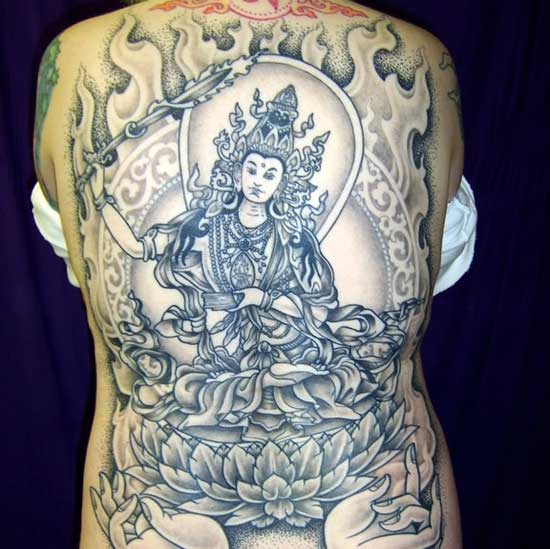
Thangka Inspired Tattoo
Especially if the artists comes from a background that have such a strong appeal on younger generations as Tattoo art.
Here an interesting article written by Heidi Minx posted on shambhalasun.com
Top tattoo artists talk Tibetan thangka art with Heidi Minx
Having studied art and dharma, and being tattooed for over two decades, my interests collided when I worked on the “Tattoos of Tibetan refugees and ex-political prisoners” project in India last year. Much of the pieces I saw were simple, hand-poked ones that frequently incorporated Bon and Tibetan symbols such as the yundon and dorjee. Here in the West, it’s common for us to see more elaborate, full-color pieces inspired by Buddhas and dharma images by very talented artists from across the ages.
In 2009, I briefly studied the process of thangka with a master in Dharamsala. The training process (a minimum of a five-year full-time commitment), as well as the discipline required, reminded me of the time-honored tradition of tattoo apprenticeships. For example, thangka students must learn the grids and proportional measurements for the three body types: male Buddhas, female Buddhas, and wrathful deities. They must first learn to draw perfectly, often drawing consistently for three years before they are even allowed to touch the paints. They must hand-grind the paints and make canvasses for the senior students — all of this reminded me of tattoo artists learning to clean shop stations properly, drawing, learning how to make needles by hand.
I’ve also learned that tattoo artists themselves often have deep admiration for this style of art, themselves. Here, three big names tell us why in their own words. (Click their names for more information about these artists and to see more of their phenomenal work.)
“I’ve been attracted to Tibetan art for a long time. In 93, I traveled through Northern India, Nepal, and Tibet, and purchased quite a few thangkas. They are beautiful and tell such elaborate stories and I know what I feel when I look at them: They seem to be a call to the primal love of god, even if they are not specific to your religion. The details, imagery, layouts — I love them. The fact that the wrathful deities are meant to protect us, it makes perfect sense to me that they be transposed to skin.
“I have tattooed a lot of the imagery over the past 20 years. The contrasting colors and the lines allow them to translate onto the skin so easily. I don’t think in general people are aware of how skilled a painter must be to create these. We can easily find the value of work by, say, Andy Warhol. Several years ago I went to have one of mine appraised. It was a 300-year-old thangka, the appraiser simply told me he didn’t know; it was worth whatever someone would pay for it.”
“Personally, I’ve always been attracted to thangka for the dynamic life/death struggle represented as well as the anthropomoprhic representations of the deities. Thangkhas contain all the elements of mystery that, when I was a young man, fascinated me about the East: strange “alien” text, hallucinogenic geometric designs, shamanistic sacrifice, otherworldly structures. It’s one art form that really has it all.”
“The process of thangka painting seems to parallel tattoo art like no other art-form. Like tattooing, the process is thousands of years old. If done correctly, the paint is hand-mixed with mineral pigments. Artists make their own canvas using natural glues and distemper on 100% cotton. The studying is intense — a minimum of five years. You must draw perfectly first, for 3 years, before you ever touch paint. Your lines must be delicate. You learn to shade with the mineral pigments, and lines must be precise and delicate. The best brushes from Japan are preferred. When it is done correctly, it is fine art.
“That reminds me of tattoos — another ancient art, originally passed on from master to student. The apprentice tattooist learns to make needles, mix colors, cut stencils and draw. The traditional tattoo apprentice must learn to pay close attention to detail and do what his teacher asks him to do. Eventually, the apprentice progresses to tattooing, maybe himself at first. Like thank painting there is a sense of discipline and respect for tradition that, when learned properly, will shine through in the work.
“These are images that tell stories, and aren’t just painted to be pretty artistic expression (although they usually are). Most importantly, they, like the best art, have the power to teach the viewer things about life.”
How To Order
- Browse our catalog and choose your favorite design.
- Select your preferred size and quality to check the price.
- Click on “Product Inquiry” to send us a message and we will check if we the artwork is immediately available. If not we will make it for you.
- Use the cart page to calculate the shipping cost by selecting your country.
- Once we receive your order we will start creating the artwork according to your preferences and provide you with updates and images upon your request.
We strive to ensure a smooth shopping experience with our assistance. We also welcome commissions of custom designs of thangkas, masks and mandalas.
Shipping and Payments
We offer trusted shipping options to ensure your purchases arrive in perfect condition, and delivered in 5 to 10 working days worldwide. We accept PayPal, debit/credit cards and bank wire transfer services.
About Our Community
We live in Changunarayan, a UNESCO heritage site located on a forested hill overlooking Bhaktapur and the Kathmandu valley. You are welcome to visit our art school and meet our community of artists and artisans.
Learn More About Our Thangka School And Workshops
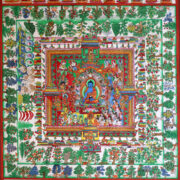 Medicine Buddha Paradise
Medicine Buddha Paradise 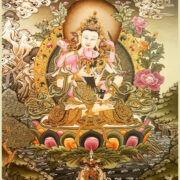 Vajrasattva
Vajrasattva 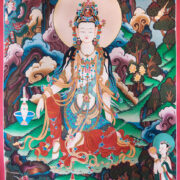 Quan Yin Thangka
Quan Yin Thangka 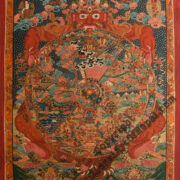 Wheel of Life 2
Wheel of Life 2 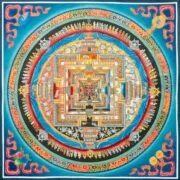 Kalachakra Mandala Auspicious Symbols
Kalachakra Mandala Auspicious Symbols 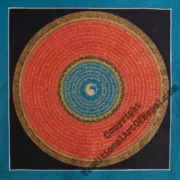 Triple Yin-Yang Mandala
Triple Yin-Yang Mandala 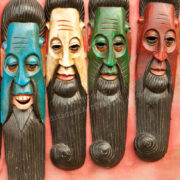 Sadhu Baba Masks
Sadhu Baba Masks 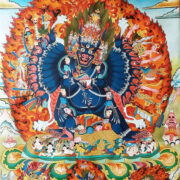 Vajrabhairava
Vajrabhairava 